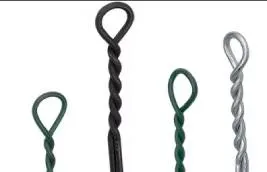-
 Phone:
Phone: -
 Email:
Email:

reinforcement tie wire
Understanding Reinforcement Tie Wire Essential for Structural Integrity
Reinforcement tie wire, commonly referred to as binding wire or rebar tie wire, plays a crucial role in construction and civil engineering projects. Its primary function involves the fastening and securing of steel reinforcement bars (rebar) during the concrete pouring process. This article explores the characteristics, applications, and importance of reinforcement tie wire in ensuring structural integrity.
Characteristics of Reinforcement Tie Wire
Reinforcement tie wire is typically made from high-quality steel, offering excellent strength and durability. It usually comes in coils or spools and is available in various gauges, commonly ranging from 16 to 18 gauge. The wire is designed to be malleable, allowing it to be easily twisted and bent without breaking. This flexibility is essential as it ensures that the wire can conform to the shape and configuration of the rebar being tied.
Furthermore, the surface of reinforcement tie wire is often coated with a layer of corrosion-resistant material, such as galvanized coating or epoxy, to enhance longevity. This is particularly important in environments subject to moisture or corrosive elements, where unprotected steel would deteriorate quickly.
Applications in Construction
The primary application of reinforcement tie wire is in the reinforcement of concrete structures. As concrete is strong under compression but weak under tension, rebar is used to enhance its tensile strength. Reinforcement tie wire is employed to secure the rebar together at intersections, ensuring that the rebar maintains its position during the placement of concrete.
The usage of tie wire extends beyond just securing individual rebar. It is crucial in the construction of complex structures, such as slabs, columns, beams, and foundations, where large amounts of rebar are required. By tightly binding the rebar, reinforcement tie wire helps create a stable framework that distributes loads effectively across the concrete.
reinforcement tie wire

In addition to standard construction practices, tie wire can also be used in more specialized applications, such as precast concrete components and in the reinforcement of masonry structures. Its versatility makes it an indispensable tool in the arsenal of builders and engineers.
Importance for Structural Integrity
The use of reinforcement tie wire is not merely a construction convenience; it is a critical component for ensuring the structural integrity and safety of a building. Properly tied rebar helps prevent shifting during the curing process of concrete, which can lead to structural weaknesses or even failures.
Moreover, the careful application of tie wire is essential for compliance with building codes and regulations. Engineers and builders must adhere to specific guidelines that dictate the appropriate spacing and tying methods for rebar to ensure maximum strength and longevity. Failure to do so can result in compromised structures, leading to costly repairs and potential safety hazards.
Conclusion
In conclusion, reinforcement tie wire is a small yet mighty component within the realm of construction. Its role in securing rebar positions, enhancing structural strength, and ensuring compliance with safety standards is paramount in any construction project. With its durability, flexibility, and resistance to corrosion, tie wire contributes significantly to the overall longevity and resilience of concrete structures.
As construction practices continue to evolve with advancements in materials and engineering techniques, the importance of reinforcement tie wire will remain steadfast. Builders and engineers must continue to value this essential tool, understanding that despite the innovations in construction technology, the foundations of safety and strength lie within the simplest of elements—like reinforcement tie wire.
In summary, as we continue to push the boundaries of architectural design and civil engineering, it is crucial to appreciate the significance of every component that supports our structures, including the often-overlooked reinforcement tie wire.
-
Wire Mesh for Every Need: A Practical SolutionNewsJul.25,2025
-
Steel Fences: Durable, Secure, and Stylish OptionsNewsJul.25,2025
-
Roll Top Fencing: A Smart Solution for Safety and SecurityNewsJul.25,2025
-
Cattle Farm Fencing Solutions for Maximum SecurityNewsJul.25,2025
-
Affordable Iron Binding Wire SolutionsNewsJul.25,2025
-
Affordable Galvanized Wire SolutionsNewsJul.25,2025
-
Wire Hanger Recycling IdeasNewsJul.25,2025








